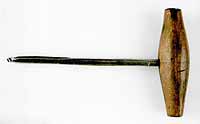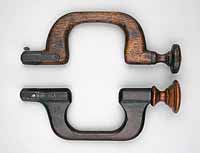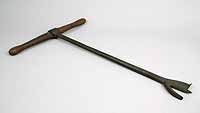Page content
Augers, Gimlets, and Braces

Unlike nose augers, screw or twist augers did not require a starting hole and automatically cleared the bored hole of shavings. They did not come into common use until after 1800.

Gimlets are small augers. They were commonly used to drill pilot holes for nails and screws, since many 18th-century nails split the wood unless it was pre-drilled.

Bitstocks (braces) and bits, designed for heavy use, were made of iron. Braces with bits, unlike augers and gimlets, bored with a continuous motion.
Tools for drilling holes in wood
Augers, gimlets, and braces were the tools used by woodworkers to drill holes in wood products. The holes ranged from the tiny mounts for harpsichord jack springs – made of hog bristles – to four- or five-inch holes bored through logs to make pumps and water pipes.
Specialized tools for unique hole requirements
Musical instrument makers and cabinetmakers drilled holes through instrument sound boards, chair splats, and galleries to begin the cuts for sound holes and pierced frets and strap work. Carpenters, shipwrights, and millwrights bored holes to clear much of the waste from large mortises for mortise-and-tenon joints and to create holes for the pins, pegs, and bolts that held their products together.
Many of these holes were not simply straight. Spinning wheel parts, wagon wheels and their axles, and barrel bungs, or stoppers, and spigots were fitted using tapered holes. The heads of wooden screws often were seated into tapered holes so that they were flush with the surface around them.
Some tools designed for one specific job
Woodworkers used many different styles and sizes of tools to bore these holes. Many, such as the huge tapered reamers used to shape holes in wheel hubs or smaller tapered bits with built-in stoppers for drillings holes to receive barrel spigots, were highly specialized and designed for only one job. Others were more general-purpose tools – augers for drilling large or deep holes, bits that fit into braces, and gimlets, which resembled miniature augers.
Many boring tools in a range of shapes and sizes survive, but unlike chisels, saws, and planes, most of the earliest appearing do not bear makers' marks or survive with documented histories. It is therefore very difficult to determine which were made in the 18th century and which were made later.

